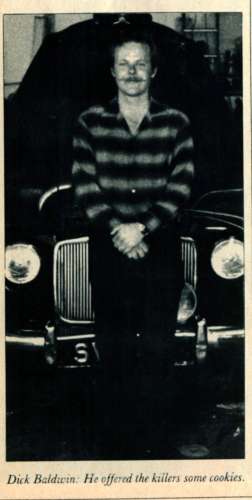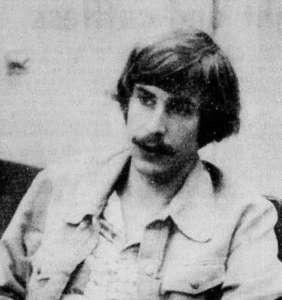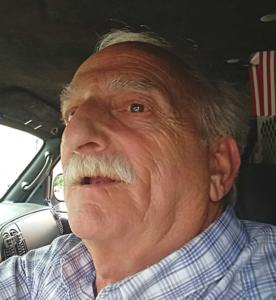The Murder of Richard Baldwin
— Paul Collin Defames the Victim
An October 29, 2018, article on the Pendragon Plot and Richard Baldwin’s murder, written by self-described investigator Paul Collin (“Unwanted Publicity Guy”) was posted on Kerry Cassidy’s (Project Camelot) web site. Much of the article is an attack upon Kevin Moore, who was working on a documentary on Captain Mark Richards and the Baldwin murder. This critique does not attempt to deal with the attack on Moore — any documentary will speak for itself and the rest is irrelevant.
There are, however, significant errors, unsupported allegations, and omissions in Collin’s article that bear upon this site’s subject. Although the article is rambling and almost incomprehensible, it is worth unpacking some of the allegations to address his view of the Richards case. Cassidy writes that her “conclusions about the murder are based on the expert investigation” by Collin. If so, she has erred in ways that would be surprising if she were really the “top journalist” that she describes herself as being.
Richard Baldwin

It appears that Collin seriously misconstrues the opinion of the federal magistrate who set aside Crossan Hoover’s conviction. (Hoover v. Carey, later reversed by the Ninth Circuit for reasons that are not relevant here.)
Crossan was the actual killer and was convicted of carrying out the killing upon Mark’s direct order. In the federal case, a magistrate described a 1982 psychological evaluation that found that Hoover was enraged after Richards claimed Baldwin was a homosexual rapist. He thought that Baldwin was looking at kids or talking about them. Hoover stated, “It made me get more angry at him and I didn’t even know him.” This does not mean that Baldwin was a known pedophile, but that Richards used Hoover’s vulnerabilities to instigate the murder.
The court’s opinion hardly benefits Richards. The magistrate found that Hoover’s mental state was compromised “by the influence of Richards and the Pendragon fantasy over him.” Circumstances in Hoover’s life culminated in “an attachment to a manipulative cult leader promising escape from a world of disillusionment.” Rather than establish a serious allegation, the court simply points out that Hoover was manipulated into murder.
Collin attempts to justify murder:
I found it ironic what may have actually attracted Richard Alexander Baldwin, who had a ‘thing’ for being “lured” ‘by these teenage boy defendants’, according to the Appellate Court, that there may have been a ‘far-more clandestine motive’ for the killing of Baldwin actually being ‘justifiable homicide’ where these ‘teenage boy defendants had undergone homosexual abuse’ at the hands of a “Chickenhawk” Baldwin would definitely be considered such a criminal perpetrator.
The quotation marks used by Collin do not indicate that the words appear in any court decision. Hoover stated that he was the victim of a sexual assault that occurred long before he met Baldwin. He never alleged that Baldwin abused him. (Hoover v. Carey; People v. Hoover.) No court, attorney, investigative reporter, or Mark at the time even hinted that Baldwin had assaulted or abused the teens employed by Richards.
Mark’s own statements at the time of the crime did not indicate that he regarded Baldwin as a “known pedophile.” It was never part of the trial. Mark made no allegation against Baldwin, even when he was specifically questioned about Baldwin’s sexuality and his statements to Hoover. Indeed, Mark acknowledged that he did not know about Baldwin’s sexuality, but used Hoover’s feelings to manipulate the teen.[2] During the investigators Interview with Richards following his arrest, Mark stated that he learned that Hoover had an intense hatred for “sexual perverts and homosexuals,” and that he used that sensitivity to “jack up” Hoover against Baldwin. Later … Continue reading
Collin maintains that his speculation amounts to new evidence, but nothing transforms this case into a “justifiable homicide.” (Cal. Pen. Code sec. 197) Collin’s attempts to blame the victim do not amount to evidence. The crime was a calculated murder lacking any justification other than Richards’s financial gain.
“My take: Hoover was their MKULtra Manchurian candidate triggered to perform the murder.” – Kerry Cassidy.
“Sometimes words fail.” – SkyMatters
“Captain” Mark Richards

Collin describes Richards as being a “highly intelligent officer and gentleman of character.” He then attempts to excuse the crime.[3] Collin repeatedly describes Richards as a captain with military training, yet no evidence to support this has ever been presented. An actual investigator would know this.
A career military officer should be asked, “What would you do if a ‘wealthy’ Chickenhawk extorted another career military officer who was ‘threatened to remain silent’ after a ‘construction job’ had its ‘teenage boy-helpers’ homosexually abused’ where if such ever became exposed it would mean the end of the career military officer’s ‘personal reputation’, ‘business reputation’, and ‘community reputation’?. . . Would a career military man take the law into his own hands and becoming Judge, Jury, and Executioner when such a threat is standing on the threshold?
The answer to this question should be self evident. Self justice is no justice and a crime regardless of the circumstances. There is no evidence apart from Collin’s imagination that Baldwin extorted or threatened anyone. But having taken the law into his own hands, would a gentleman of character lie to investigators about why he had possession of items belonging to Baldwin and used Baldwin’s credit card after the murder? When this did not work, would an honorable career military officer assert that he only tried to cover up the murder out of a misguided loyalty to the teens who worked for him? Perhaps most importantly, would a space captain have used a vulnerable and disturbed teen to carry out a murder or attempt to profit by the killing?
Collin writes that Mark’s role was unclear. To the extent that he suggests that Mark may have become a judge, jury, and executioner is remarkable, however, given that Mark has maintained that he had nothing to do with the crime. Collin’s suppositions would make Mark guilty.
The Trials and the Legal System
Collin is misinformed about a number of matters and seemingly did not undertake even the most basic research into the trials of Mark and Crossan or the relevant law. As an example, he does not know the punishment for murder and asserts that “technically and legally speaking to the sentence of Hoover, he should have already been released from prison no later than 1990.” No. An indeterminate term is indeterminate and a person who is serving a life sentence, and is eligible for parole, is not certain to be released.[4] The baseline punishment for second degree murder is 25 years to life, not 40 years as Collin states in his article. Crossan became eligible for parole in 1999. The Board of Parole Hearings found him suitable for parole on September 25, 2018 — although the governor later … Continue reading
Collin also asserts that Andrew Campbell, the third teen involved in the crime, was found guilty.
Defendants Hoover, Campbell and Captain Mark Richards were all found guilty, even though 2 defendants (Mark Richards and Campbell ) did ‘not kill Baldwin.
In America’s skewed court system, ‘complicity’ presence or knowledge of a crime of ‘murder’ means ‘all will be found guilty of murder’; even in cases where only 1 defendant committed the actual ‘killing’
Contrary to Collin’s understanding, Campbell testified in exchange for immunity and was not tried. This basic error is surprising since it shows a lack of any real knowledge. Mark used the grant of immunity during his trial to argue that Campbell’s testimony should not be believed. That is a legitimate defense. Collin’s speculation is not.
There is no single “America’s skewed court system.” California provides that anyone who is “in” on a crime may be prosecuted as a principal offender. If you willfully aid and abet a crime you cannot evade the consequences. If you knowingly instigate a crime you are liable regardless of whether you are the final perpetrator. (Cal. Pen Code sec. 31.)
This is a basic principle of liability — the same principle that made Nazi leaders liable for war crimes perpetuated by others or led to Charles Manson’s guilt verdict for murders carried out by others.
Still, it has to be asked, how remote was Richards from the crime? Evidence established that Mark had approached two others about killing Baldwin; Mark admitted that he manipulated Crossan against Baldwin; Mark was there when the murder happened; he gave the signal for Crossan to kill; he bought a boat with proceeds from the crime in order to dispose of the body; he used Baldwin’s credit cards to go on a spending spree and took Baldwin’s belongings; he lied to police investigators. The trial court found that there was overwhelming evidence to support a murder verdict.
The Disappearing Witness
Collin speculates about the California Court of Appeal’s ruling on the pre-trial writ filed by Richards. (Richards v. Superior Court.) The court noted that Richards approached another employee, William Robles, about killing Baldwin, explaining that he was was broke and needed money fast. “Robles told petitioner he would think about it, but joined the Navy in late June, disappearing from the scenario.”
Collin attempts to make this into something mysterious.
Did a Witness named William Robles ever attest-to or testify at the murder trial, or did he as the Appellate Court ruling, claimed, ‘simply’ “disappeared from the scenario” (crime scene)?
Although Collin attaches importance to the wording that Robles disappeared, there is nothing mysterious about this. It simply means that Robles no longer worked for Richards and was not part of the crime. Indeed, it was reported that Robles joined the Navy as a way to leave Pendragon after Richards talked about murder and threatened him.(California Magazine, “Medieval Murder in Marin.”)
The answer to Collin’s question is easily found by any investigator or reader with a general knowledge of the trial. Robles was a testifying witness, who told jurors about how Mark used Pendragon, paid him to recruit new members, and tried to get him to kill Baldwin. (See People v. Richards [denying claim that errors affecting Robles’s testimony were particularly harmful]; Murder in Camelot.)
The Case of the Cookies
Collin also attempts to find something sinister with the court’s statement, “After lunch [Richards] conversed with Baldwin, who showed his visitors several of his cars and invited them inside for cookies. Campbell now explained that, while Hoover had an interest in cars and wanted to see those in Baldwin’s shop, he would himself rather stay and work on the house.”
Collin appears to be mystified by this, wondering who the visitors were and what were the cookies:
Did Baldwin offer glasses of ‘milk’ with his “cookies” to ‘underage minor children’ or ‘teenagers’? Was Baldwin offering his ‘visitors’ a taste of customary ‘British’ ‘tea’ and ‘crumpets’ that the Appellate court described as “cookies”? Or, were Baldwin’s “cookies” actually ‘marijuana cookies’ those ‘laced’ with – during that era of time time ( 1981 – ) when such ‘illegal narcotics’ was was ‘punishable by imprisonment marijuana’ – ‘drugs documented by the Appellate court’ as stolen from Baldwin’s home’? What ‘else’ ‘more’ was found to be ‘illegal’ within Baldwin’s house?
It is clear that the visitors were Richards and his employees — Campbell and Hoover. As was reported, Richards joked that it might be Baldwin’s last day on earth, but Baldwin did not catch on and took something out of the oven, asking if anyone wanted cookies. (California Magazine, “Medieval Murder in Marin”.) Why wouldn’t Baldwin offer the teens cookies?
There is no reason for Collin to make Baldwin’s offer into something evil. Mark was his friend. Baldwin loved cookies and acted like a friend. So when he served cookies, they were oatmeal-raisin. The only thing surprising is that Baldwin did not serve chocolate chip, which he particularly loved. Perhaps Collin can offer up a theory to explain the “great cookie switch.”
Campbell specifically testified that Baldwin did not offer them marijuana. (Preliminary Hearing, p. 106.) There is no basis to speculate about anything else that might have been meant. The quotation marks that Collin inserts does not indicate any source other than himself. In light of the readily available information identifying the cookies, it is astonishing that Collin raises this issue. He does more than let his imagination run wild, he again tries to defame the victim.
A New Theory?
Collin asserts Mark’s nonexistent military training made him snap.
Military soldier mindsets are ‘not passive attitudes’. Militarized ‘code” mindsets border on quasi-psychotic, and when soldiers and prisoners SNAP.
I believe Mark, from his military bearing and observational trainings was able to quickly assess Baldwin’s behavioral ( e.g. body expressions, sordid colloquies, etc. ) and / or ‘other escapades’, forcing Mark to bite his own lip for perhaps, a long time while the welling-up of such emotionally mind-wrenching seethings over Baldwin’s disgusting behavior would cause him to snap-out horrid comments. But, to carry such through to the point of really mapping-out a murder like a schematic?
It should be noted that if Mark had assessed Baldwin’s “disgusting behavior” then why was he Mark’s best friend, a frequent guest at Mark’s parents, and an honored person at Mark’s wedding, the one who chauffeured Mark and his bride after the ceremony? Why did Mark bring a crew to Baldwin’s home rather than leave as soon as there was disgusting behavior?
“[It] boils down to whose testimony is one going to believe. Underage teenagers whose adolescent world is ‘all about them’, attracted to things like cool cars, then-illegal drugs, and all the fast times at Ridgemont High popularity they can grab (one way or another ), or are you willing to sit down with an officer and a gentleman who’s only ‘talking in an interview about COSMIC level secret issues’ while he remained moot, by, ‘not’ saying anything about his ( Richards ) court case.” – Paul Collin
Collin suggests that the teens acted without Mark’s knowledge. This theory is similar to Mark’s defense at trial that he was misinterpreted by the teen killers — that he helped cover up the murder rather than instigate it. The jurors ultimately rejected this explanation. At the very least it is a far different picture than what Mark has since asserted.
It is not necessary to go through other erroneous statements made by Collin. His “investigation” is fraught with mistakes and omissions. It is appalling that he attacked the victim without any basis other than his own speculation and complete misunderstanding. He does not provide Mark with a cognizable defense.
A Moment of Truth?

Audiences may begin their own path of even-better discernment as they become enlightened with ‘hidden facts’ ring-fencing The Tres Amigos (Dumb, Dumber and Dumbest) whom ‘incorrectly discerned for public audiences’ while they continued wildly carrying-on simultaneous public attacks on two ( 2 ) professional women.
Reviewing ‘basic criminal court case facts’, outside public purview, now sees ‘Research References’ supplied for even-better discernment by general public audiences.
The material Collin uses has long been posted on this and other sites. Moore has been subject to criticism by Mark, in part, because he has released substantial documentation related to the case that Collin does not appear to understand.
Collin simply repeats his basic allegation by offering
a peek into far greater scandalous activities leading to a criminal court case situation multiply proven to have wrongfully prosecuted and misled an empanelled courtroom Jury away-from clear and convincing evidence verdict of a ‘justifiable homicide’ where a wealthy car collector who was also a ‘homosexual pedophile stalker’ was ‘wrongfully murdered’.”
For all the reasons stated above, the murder was not a justifiable homicide and there is no evidence that Mr. Baldwin was a pedophile stalker. Collin takes information about how Mark manipulated Crossan, embellishes it with his own imagination, and tries to pass it off as a “fact.” He applies a familiar theme relating to conspiracies: tell a lie that is linked to an abhorrent crime then hope that it taints the victim so that the lie is believed.
Enough said about that.
Collin Returns
In a second article, Collin returns to his theme but makes no more sense. Statements such as this defy any rational response, but not because the argument is persuasive:
n an odd display of events, the dogs of the District Attorney prosecution team re-joined mainstream news media dogs whom mysteriously had individuals come to them testifying that they had somehow been ‘members’ of the “Pendragon” ‘cult’. Then again, were not dealing with Rhodes scholars whom majored in the English language so maybe those that came forward actually belonged to an ‘occult’ group named ‘Pentagram’ and so perhaps, put-forward was just yet another confusing example of rocket scientists who are not phonetic geniuses at sounding-out or spelling words either.
Nevertheless, there is some irony to this paragraph because Richards is the only one in this story who claims to be a Rhodes Scholar — although it is disproven. As to the word “Pendragon” it was clearly a term chosen by Mark. (See Mark’s book Imperial Marin; Witnesses testimony about Pendragon.) Collin is the only one confused by it. His utter lack of an investigation is apparent.
The new article is as incomprehensible as the old. Collin leaves us with stolen valor, stolen intellect, and a stolen history – the only thing true is the nature of true crime itself. The article demonstrates why critical thinking and the ability to substantiate claims is important.
Notes:
| ⇧1 | Kerry Cassidy repeats these accusations in her tenth interview with Mark. Jo Ann has even claimed that Baldwin was a drug dealer and child pornographer. (Kevin Moore Show, Interview with Jo Ann, March 28, 2015.) The Baldwin family deserve better than this. |
|---|---|
| ⇧2 | During the investigators Interview with Richards following his arrest, Mark stated that he learned that Hoover had an intense hatred for “sexual perverts and homosexuals,” and that he used that sensitivity to “jack up” Hoover against Baldwin. Later in the interview, Mark stated that he did not know for certain whether Baldwin was gay or bisexual, although he had seen Baldwin with women.
Perhaps the only thing on the public record remotely having to do with Baldwin’s personal life is that he double-dated with Mark, Mark’s first wife, and her twin sister. |
| ⇧3 | Collin repeatedly describes Richards as a captain with military training, yet no evidence to support this has ever been presented. An actual investigator would know this. |
| ⇧4 | The baseline punishment for second degree murder is 25 years to life, not 40 years as Collin states in his article. Crossan became eligible for parole in 1999. The Board of Parole Hearings found him suitable for parole on September 25, 2018 — although the governor later reversed that decision.
Contrary to what Paul Collin writes, Crossan was never released from prison — even temporarily — by a federal court. |

